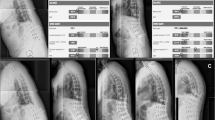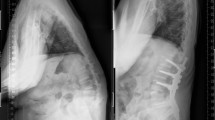Abstract
Purpose
(1) Evaluate the associations between L1-pelvic angle (L1PA) and both sagittal vertical axis (SVA) and T1-pelvic angle (T1PA), and (2) assess the clinical impact of L1PA.
Methods
A single-institution retrospective cohort study was undertaken for patients undergoing adult spinal deformity (ASD) surgery from 2013 to 2017. Ideal L1PA was defined as (0.5xPelvic Incidence)-21. Pearson correlation was performed to compare L1PA, SVA, and T1PA. Univariate/multivariate regression was performed to assess the effect of L1PA on mechanical complications, controlling for age, BMI, and postoperative pelvic incidence-lumbar lordosis mismatch (PI/LL). Due to the overlapping nature of patients with pseudarthrosis and rod fracture, these patients were analyzed together.
Results
A total of 145 patients were included. Mean preoperative L1PA, SVA, and T1PA were 15.5 ± 8.9°, 90.7 ± 66.8 mm, and 27.1 ± 13.0°, respectively. Mean postoperative L1PA, SVA, and T1PA were 15.0 ± 8.9°, 66.7 ± 52.8 mm, and 22.3 ± 11.1°, respectively. Thirty-six (24.8%) patients achieved ideal L1PA. Though the correlation was modest, preoperative L1PA was linearly correlated with preoperative SVA (r2 = 0.16, r = 0.40, 95%CI = 0.22–0.60, p < 0.001) and T1PA (r2 = 0.41, r = 0.62, 95%CI = 0.46–0.76, p < 0.001). Postoperative L1PA was linearly correlated with postoperative SVA (r2 = 0.12, r = 0.37, 95%CI = 0.18–0.56, p < 0.001) and T1PA (r2 = 0.40, r = 0.62, 95%CI = 0.45–0.74, p < 0.001). Achieving ideal L1PA ± 5° was associated with a decreased risk of rod fracture/pseudarthrosis on univariate and multivariate regression (OR = 0.33, 95%CI = 0.12–0.86, p = 0.024). No association between achieving ideal L1PA and patient-reported outcomes was observed.
Conclusion
L1PA was modestly correlated with SVA and T1PA, and achieving ideal L1PA was associated with lower rates of rod fracture/pseudarthrosis. Future studies are warranted to better define the clinical implications of achieving a normal L1PA.
Level of evidence
III.



Similar content being viewed by others
References
Dinizo M, Dolgalev I, Passias PG et al (2021) Complications after adult spinal deformity surgeries: all are not created equal. Int J Spine Surg 15:137–143. https://doi.org/10.14444/8018
Massaad E, Hadzipasic M, Kiapour A et al (2021) Association of spinal alignment correction with patient-reported outcomes in adult cervical deformity: review of the literature. Neurospine 18:533–542. https://doi.org/10.14245/ns.2040656.328
Schwab F, Dubey A, Gamez L et al (2005) Adult scoliosis: prevalence, SF-36, and nutritional parameters in an elderly volunteer population. Spine (Phila Pa 1976) 30:1082–1085. https://doi.org/10.1097/01.brs.0000160842.43482.cd
Bess S, Boachie-Adjei O, Burton D et al (2009) Pain and disability determine treatment modality for older patients with adult scoliosis, while deformity guides treatment for younger patients. Spine (Phila Pa 1976) 34:2186–2190. https://doi.org/10.1097/BRS.0b013e3181b05146
Cristante AF, Silva RTE, da Costa GHR, Marcon RM (2021) Adult degenerative scoliosis. Rev Bras Ortop (Sao Paulo) 56:1–8. https://doi.org/10.1055/s-0040-1709736
Yadla S, Maltenfort MG, Ratliff JK, Harrop JS (2010) Adult scoliosis surgery outcomes: a systematic review. Neurosurg Focus 28:E3. https://doi.org/10.3171/2009.12.FOCUS09254
Banno T, Hasegawa T, Yamato Y et al (2016) T1 pelvic angle is a useful parameter for postoperative evaluation in adult spinal deformity patients. Spine (Phila Pa 1976) 41:1641–1648. https://doi.org/10.1097/BRS.0000000000001608
Li W, Zhou S, Zou D et al (2021) Which global sagittal parameter could most effectively predict the surgical outcome for patients with adult degenerative scoliosis? Global Spine J. https://doi.org/10.1177/21925682211043465
Youn Y-H, Cho K-J, Na Y, Kim J-S (2022) Global sagittal alignment and clinical outcomes after 1–3 short-segment lumbar fusion in degenerative spinal diseases. Asian Spine J 16:551–559. https://doi.org/10.31616/asj.2021.0182
Glassman SD, Bridwell K, Dimar JR et al (2005) The impact of positive sagittal balance in adult spinal deformity. Spine (Phila Pa 1976) 30:2024–2029. https://doi.org/10.1097/01.brs.0000179086.30449.96
Cho K-J, Kim Y-T, Shin S-H, Suk S-I (2014) Surgical treatment of adult degenerative scoliosis. Asian Spine J 8:371–381. https://doi.org/10.4184/asj.2014.8.3.371
Kim YJ, Bridwell KH, Lenke LG et al (2006) Pseudarthrosis in adult spinal deformity following multisegmental instrumentation and arthrodesis. J Bone Joint Surg Am 88:721–728. https://doi.org/10.2106/JBJS.E.00550
Cho K-J, Suk S-I, Park S-R et al (2010) Risk factors of sagittal decompensation after long posterior instrumentation and fusion for degenerative lumbar scoliosis. Spine (Phila Pa 1976) 35:1595–1601. https://doi.org/10.1097/BRS.0b013e3181bdad89
Hills J, Lenke LG, Sardar ZM et al (2022) The T4–L1-Hip Axis: defining a normal sagittal spinal alignment. Spine (Phila Pa 1976) 1:10–1200. https://doi.org/10.1097/BRS.0000000000004414
Ames CP, Smith JS, Scheer JK et al (2012) Impact of spinopelvic alignment on decision making in deformity surgery in adults: a review. J Neurosurg Spine 16:547–564. https://doi.org/10.3171/2012.2.SPINE11320
Yilgor C, Sogunmez N, Boissiere L et al (2017) Global alignment and proportion (GAP) score: development and validation of a new method of analyzing spinopelvic alignment to predict mechanical complications after adult spinal deformity surgery. J Bone Joint Surg Am 99:1661–1672. https://doi.org/10.2106/JBJS.16.01594
Glattes RC, Bridwell KH, Lenke LG et al (2005) Proximal junctional kyphosis in adult spinal deformity following long instrumented posterior spinal fusion: incidence, outcomes, and risk factor analysis. Spine 30:1643–1649. https://doi.org/10.1097/01.brs.0000169451.76359.49
Barton C, Noshchenko A, Patel V et al (2015) Risk factors for rod fracture after posterior correction of adult spinal deformity with osteotomy: a retrospective case-series. Scoliosis 10:30. https://doi.org/10.1186/s13013-015-0056-5
Choi SH, Son SM, Lee D-H et al (2018) L1 incidence reflects pelvic incidence and lumbar lordosis mismatch in sagittal balance evaluation. Medicine (Baltimore) 97:11668. https://doi.org/10.1097/MD.0000000000011668
Protopsaltis TS, Lafage R, Smith JS et al (2018) The lumbar pelvic angle, the lumbar component of the T1 pelvic angle, correlates with HRQOL, PI-LL mismatch, and it predicts global alignment. Spine (Phila Pa 1976) 43:681–687. https://doi.org/10.1097/BRS.0000000000002346
Sebaaly A, Gehrchen M, Silvestre C et al (2020) Mechanical complications in adult spinal deformity and the effect of restoring the spinal shapes according to the Roussouly classification: a multicentric study. Eur Spine J 29:904–913. https://doi.org/10.1007/s00586-019-06253-1
Kim K-R, Le Huec J-C, Jang H-J et al (2021) Which is more predictive value for mechanical complications: fixed thoracolumbar alignment (T1 pelvic angle) versus dynamic global balance parameter (Odontoid-Hip Axis Angle). Neurospine 18:597–607. https://doi.org/10.14245/ns.2142452.226
Gao A, Wang Y, Yu M et al (2020) Association between radiographic spinopelvic parameters and health-related quality of life in De Novo degenerative lumbar scoliosis and concomitant lumbar spinal stenosis. Spine (Phila Pa 1976) 45:E1013–E1019. https://doi.org/10.1097/BRS.0000000000003471
Chanbour H, Roth SG, LaBarge ME et al (2022) The postoperative course of mechanical complications in adult spinal deformity surgery. Spine Deform. https://doi.org/10.1007/s43390-022-00576-8
Zuckerman SL, Chanbour H, Hassan FM et al (2022) Evaluation of coronal alignment from the skull using the novel orbital-coronal vertical axis line. J Neurosurg Spine 10:1–10. https://doi.org/10.3171/2022.1.SPINE211527
Acknowledgements
None.
Funding
This study did not receive funding from any institution or grant.
Author information
Authors and Affiliations
Corresponding author
Ethics declarations
Conflict of interest
Dr. Stephens is a consultant for Nuvasive and Carbofix and receives institutional research support from Nuvasive and Stryker Spine. Dr. Zuckerman reports being an unaffiliated neurotrauma consultant for the National Football League. Dr. Abtahi receives an institutional research support from Stryker Spine. No other perceived conflict of interest by any of the listed authors.
Ethical approval
This study was approved by the IRB committee at Vanderbilt University Medical Center (IRB#211290). We certify that the study was performed in accordance with the ethical standards as laid down in the 1964 Declaration of Helsinki and its later amendments or comparable ethical standards.
Previous presentations
Podium Presentation Southern Orthopedic Association (SOA) 2022, Greenbrier, WV.
Additional information
Publisher's Note
Springer Nature remains neutral with regard to jurisdictional claims in published maps and institutional affiliations.
Rights and permissions
Springer Nature or its licensor (e.g. a society or other partner) holds exclusive rights to this article under a publishing agreement with the author(s) or other rightsholder(s); author self-archiving of the accepted manuscript version of this article is solely governed by the terms of such publishing agreement and applicable law.
About this article
Cite this article
Chanbour, H., Waddell, W.H., Vickery, J. et al. L1-pelvic angle: a convenient measurement to attain optimal deformity correction. Eur Spine J 32, 4003–4011 (2023). https://doi.org/10.1007/s00586-023-07920-0
Received:
Revised:
Accepted:
Published:
Issue Date:
DOI: https://doi.org/10.1007/s00586-023-07920-0




